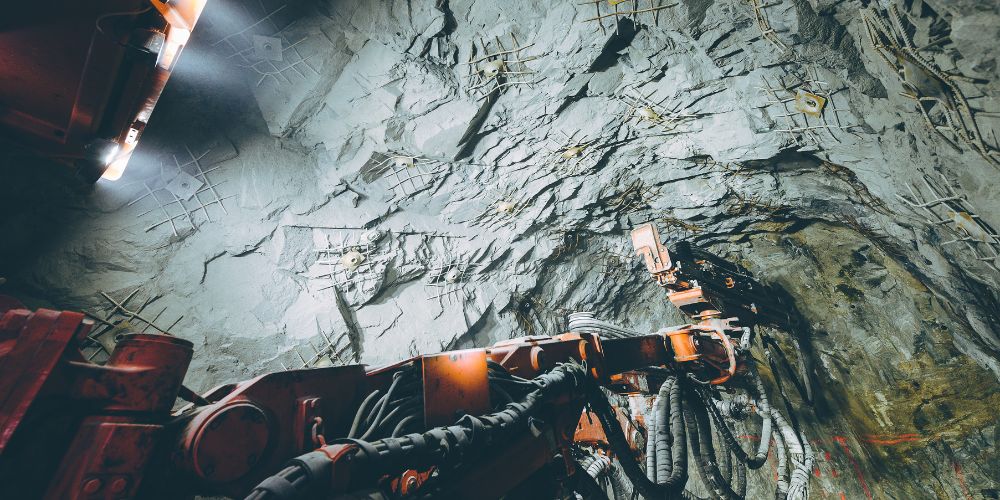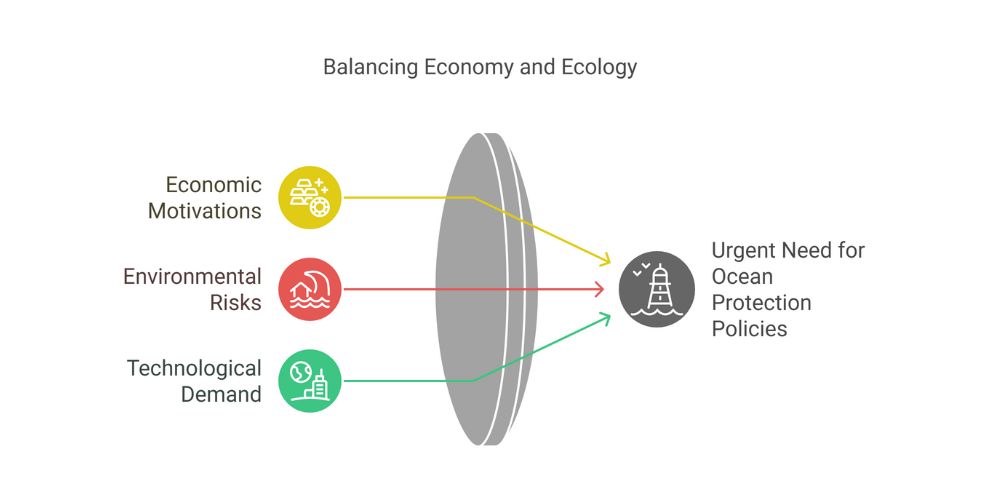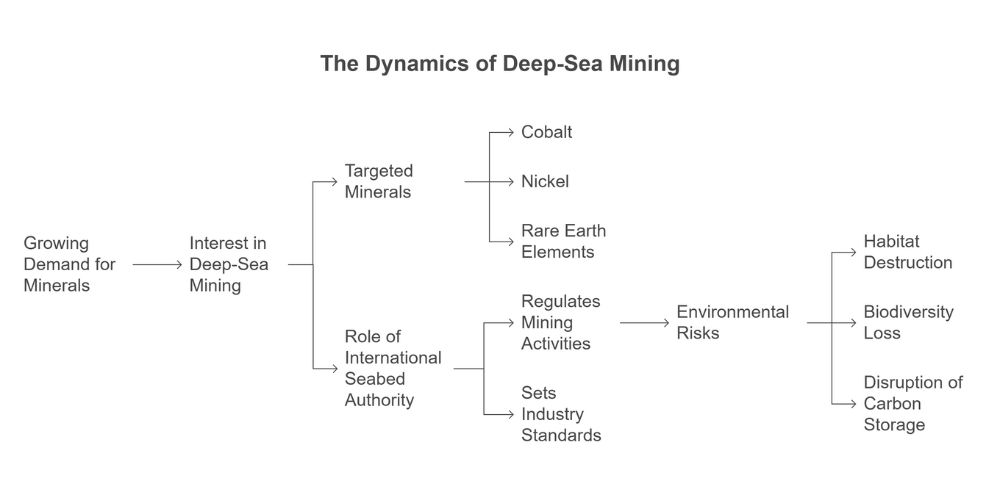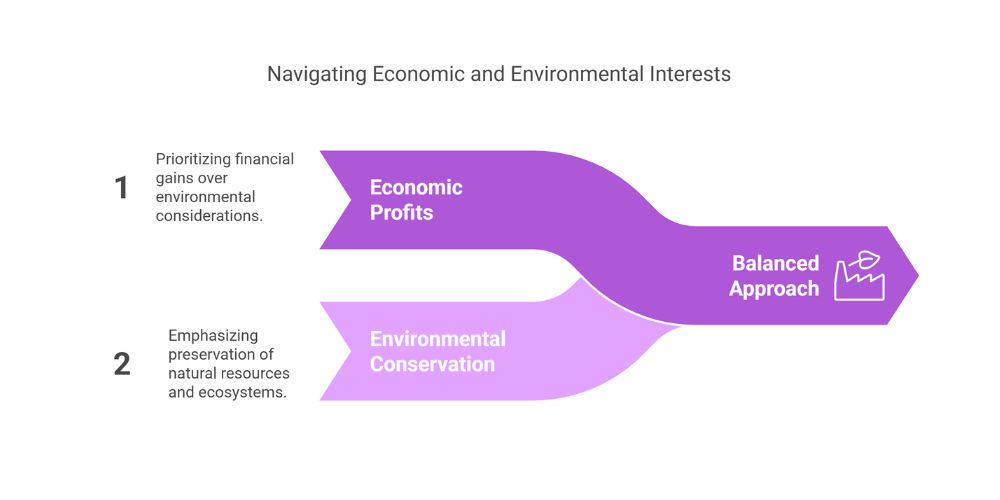
Deep-Sea Mining: A Hidden Threat to Ocean Ecosystems in 2025
Posted by on April 9, 2025
The deep ocean contains delicate ecosystems that scientists currently understand the least.
The deep ocean contains delicate ecosystems that scientists currently understand the least. Earth’s ocean depths are the last remaining ecosystems on the planet that remain largely untouched by industrial operations. Unfortunately, the push for deep-sea mining is rapidly gaining traction, threatening to disrupt these fragile and unexplored environments.

Deep-sea mining involves extracting valuable minerals such as cobalt, nickel, and other rare earth elements from the ocean floor. Currently, these minerals are primarily sourced from terrestrial mines, often in regions where mining operations result in significant environmental degradation, deforestation, and social conflicts. The push for deep-sea mining arises from concerns about supply limitations and geopolitical control over these land-based resources. These minerals are essential for modern technologies, including electric vehicle batteries, wind turbines, and other renewable energy infrastructure. However, while these resources fuel the transition to clean energy, mining them from the seabed poses irreversible risks to marine ecosystems.
The expansion of deep-sea mining in 2025 is raising serious concerns about habitat destruction, biodiversity loss, and disruptions to oceanic carbon storage. This article examines the economic motivations behind deep-sea mining, weighs them against the environmental consequences, and explores the urgent need for stronger ocean protection policies.
The Growing Interest in Deep-Sea Mining

The rising demand for minerals used in green technologies—such as electric vehicle batteries, wind turbines, and solar panels—is driving global interest in deep-sea mining. Many nations and corporations view the deep ocean as an untapped resource capable of supplying essential materials for renewable energy expansion.
The International Seabed Authority (ISA), an independent global agency, regulates deep-sea mining activities and establishes industry standards.
Currently, deep-sea mining operations target three primary minerals:
- Cobalt – A key component in lithium-ion batteries for electric vehicles and renewable energy storage systems.
- Nickel – Essential for lithium-ion battery production and widely used in corrosion-resistant alloys.
- Rare Earth Elements (REEs) – A group of 17 chemically similar elements critical for electronics, wind turbines, and defense technologies.
While these minerals are vital for sustainable energy solutions, extracting them from the ocean floor poses serious environmental risks, including severe biodiversity loss, irrevocable habitat destruction, and unquantified disruptions to oceanic carbon storage. Deep-sea scientists from institutions like Scripps note that the majority of biodiversity in the deep sea lives on the metallic nodules targeted for extraction—structures that take millions of years to form. Much of the marine life also lives in the upper sediment layers, which are permanently perturbed during mining. Exploratory dredges show these ecosystems do not recover, even decades later. The severity of this destruction cannot be understated.
Environmental Impacts of Deep-Sea Mining

The deep ocean contains delicate ecosystems that remain among the least understood on the planet. Seabed mining operations disrupt these environments, often causing irreversible damage. Below are the key environmental impacts associated with deep-sea mining:
1. Habitat Destruction and Biodiversity Loss:
Deep-sea species have adapted over millions of years to survive in extreme conditions—such as high pressure, low temperatures, and limited sunlight. Hydrothermal vents, abyssal plains, and seamounts provide habitats for unique marine organisms, many of which exist nowhere else on Earth. Deep-sea mining requires large-scale extraction of the seafloor, permanently altering these ecosystems and leading to significant biodiversity loss. The true scale of biodiversity loss is staggering. Not only are many of these species endemic, but the areas targeted for mining overlap directly with the key habitats that support their survival. Currently, there is no known way to avoid permanently destroying all of this life—including species not yet discovered or described.
2. Sediment Plumes and Ocean Pollution
One of the most concerning effects of deep-sea mining is the generation of sediment plumes—clouds of disturbed particles that can spread over vast distances. These plumes may introduce heavy metals and toxins into the water column, smother deep-sea organisms, and disrupt vital biological processes such as feeding and reproduction. The full extent of their impact is unknown: How far do they spread? How long do they persist? Could they harm marine life at different depths? Scientists have yet to answer these critical questions.
A real-world example highlighting the potential risks comes from a 2020 study conducted by the German research vessel SONNE. The study simulated a small-scale seabed mining disturbance in the Pacific Ocean’s Clarion-Clipperton Zone. Researchers found that sediment plumes traveled farther than anticipated, with fine particles remaining suspended in the water column for extended periods. The study also documented a 43% reduction in biodiversity in affected areas even after decades, raising concerns about the long-term impacts of large-scale mining operations.
3. Disruptions to Ocean Carbon Sequestration
The deep ocean plays a crucial role in regulating Earth's climate by storing vast amounts of carbon within seabed sediments. Disturbing these sediments through mining would release stored carbon, altering ocean chemistry and potentially reducing the ocean’s ability to regulate temperatures. This could contribute to further climate instability, though the exact scale of this impact remains uncertain.
For more information regarding carbon sequestration and the ocean’s role in regulating global climate, read: Mangroves and Seagrasses: Key Players in Carbon Sequestration
4. Impacts on Fisheries and Coastal Communities
Seabed mining could have cascading effects on global fisheries by damaging deep-sea habitats that support fish populations. Disruptions to these marine ecosystems may reduce fish stocks, affecting food security and the livelihoods of coastal communities that depend on marine resources. Small island nations and regions with economies tied to fishing could be especially vulnerable, but the global implications remain underexplored.
The Economic Debate: Profits vs. Conservation

Deep-sea mining has garnered support from major industrial sectors, particularly those involved in technology manufacturing and renewable energy production. Proponents argue that seabed mineral extraction can reduce reliance on conflict minerals sourced from terrestrial mines, where human rights abuses and environmental degradation are rampant. Countries like China and Japan have invested heavily in deep-sea mining research, citing the need for securing rare earth metals essential for battery production, electronics, and clean energy technologies.
For many developing nations, deep-sea mining represents a potential economic lifeline. Countries with limited land-based mineral resources see seabed mining as an opportunity to generate revenue, attract foreign investment, and establish a competitive position in the global market for critical minerals. Pacific Island nations, for example, have explored partnerships with international mining firms to license mining activities within their exclusive economic zones, arguing that the financial benefits could support national development and infrastructure projects.
However, marine conservation experts and environmental scientists warn that the extraction of these minerals from the deep sea is fundamentally unsustainable. Mining activities physically disrupt fragile ecosystems, releasing toxic metals into the water column and threatening marine biodiversity. The economic drive for new resource sources is fueling pressure to begin extraction before scientists fully understand the consequences.
Some governments, such as Chile, Palau, Fiji, and Vanuatu, have implemented moratoriums or outright bans on deep-sea mining until comprehensive environmental assessments can be conducted. France originally supported a moratorium but has since reconsidered. Island nations—despite their smaller geopolitical influence—are leading the charge in calling for ocean protection, recognizing they are on the frontlines of both climate change and the risks posed by ocean exploitation. Meanwhile, companies like Umicore and Redwood Materials are advancing battery recycling and sustainable mineral recovery as alternatives to deep-sea extraction. These efforts highlight the potential for resource circularity—where materials are repurposed and reused—rather than expanding destructive mining operations into the ocean
Sustainable Alternatives and Future Solutions

Rather than exploiting deep-sea ecosystems for mineral extraction, several approaches offer more sustainable solutions.
1. Recycling and Urban Mining
Urban mining refers to the recovery of valuable minerals from discarded electronic devices, industrial waste, and retired batteries. This process reduces the demand for newly mined materials by extracting metals like lithium, cobalt, and nickel from e-waste.
2. Improving Land-Based Mining Practices
Urban mining refers to the recovery of valuable minerals from discarded electronic devices, industrial waste, and retired batteries. This process reduces the demand for newly mined materials by extracting metals like lithium, cobalt, and nickel from e-waste. Companies such as Redwood Materials and Umicore are leading the way in this space.
3. Strengthening Marine Protection Laws and Enforcement
In addition to moratoriums, countries like Samoa and the Federated States of Micronesia have taken significant steps by joining an alliance with Palau and Fiji to oppose deep-sea mining, calling for a global moratorium on such activities (Greenpeace). Furthermore, the Melanesian Spearhead Group—which includes Fiji, Papua New Guinea, the Solomon Islands, Vanuatu, and others—has issued a collective moratorium on seabed mining within their jurisdictions, emphasizing the importance of scientific research and ecological protection (Mining.com). These frameworks reflect a growing global movement toward stronger marine protection, setting important precedents for sustainable ocean governance.
4. Alternative Battery Technologies
Emerging technologies like sodium-ion and solid-state batteries may reduce dependency on seabed minerals.
The Future of Ocean Mining: Regulation or Exploitation?
Scientific research and public awareness will play a pivotal role in shaping the future of ocean mining legislation. Given the certainty of irreversible damage to deep-sea ecosystems, policymakers must act swiftly to establish sustainable and effective regulations.
The Role of Marine Research and Conservation
Over the years, findings from marine research have influenced policy changes and industry regulations, leading to stricter environmental protections and more sustainable ocean management practices. Scientific studies on deep-sea ecosystems have informed moratoriums on deep-sea mining and encouraged the development of alternative resource extraction methods. Institutions like the Oceans Research Institute contribute to these efforts through marine research training programs that equip scientists with the expertise to study and protect fragile deep-sea environments.
Conclusion
Seabed mining presents significant environmental risks that threaten ocean ecosystems. Instead of pursuing seabed mining, efforts should focus on stricter regulations, alternative materials, and long-term research on ecological consequences. Increased funding for ocean conservation and marine research can ensure that economic and environmental priorities align for a more sustainable future.